

Compact Muon Solenoid
LHC, CERN
| CMS-PAS-EXO-22-026 | ||
| Model-agnostic search for dijet resonances with anomalous jet substructure in proton-proton collisions at $ \sqrt{s} $ = 13 TeV | ||
| CMS Collaboration | ||
| 25 March 2024 | ||
| Abstract: This note introduces a model-agnostic search for new physics in the dijet final state. Other than the requirement of a narrow dijet resonance with a mass in the range of 1800-6000 GeV, minimal additional assumptions are placed on the signal hypothesis. Search regions are obtained by utilizing multivariate machine learning methods to select jets with anomalous substructure. A collection of complementary anomaly detection methods -- based on unsupervised, weakly-supervised and semi-supervised algorithms -- are used in order to maximize the sensitivity to unknown new physics signatures. These algorithms are applied to data corresponding to an integrated luminosity of 138 fb$ ^{-1} $, recorded in the years 2016 to 2018 by the CMS experiment at the LHC, at a centre-of-mass energy of 13 TeV. No significant excesses above background expectation are seen, and exclusion limits are derived on the production cross section of benchmark signal models varying in resonance mass, jet mass and jet substructure. Many of these signatures have not previously been searched for at the LHC, making the limits reported on the corresponding benchmark models the first ever and the most stringent to date. | ||
| Links: CDS record (PDF) ; Physics Briefing ; CADI line (restricted) ; | ||
| Figures | |
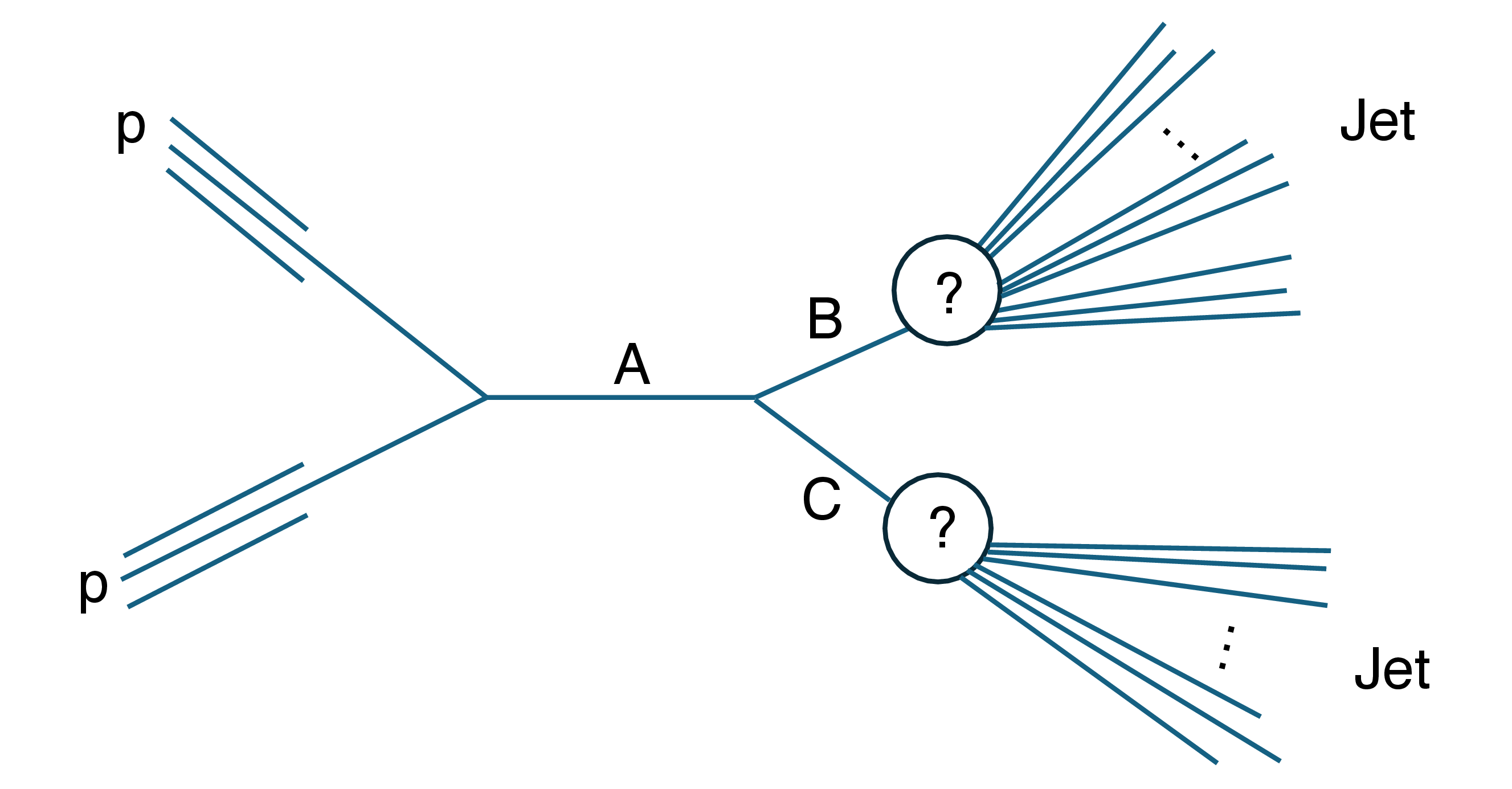
png pdf |
Figure 1:
Production in pp collisions of a dijet resonance, A, which decays to two resonances B and C, that in turn each decay to a jet with anomalous substructure arising from multiple subjets. |
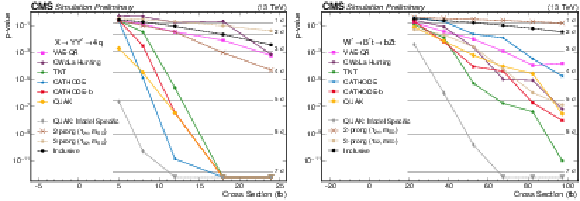
png pdf |
Figure 2:
P-values as a function of the injected signal cross sections for the different analysis procedures on for two different signals: (left) the 2-pronged $ \mathrm{X} \to \mathrm{YY'} \to 4 \mathrm{q} $ signal with $ M_{\mathrm{X}}= $ 3 TeV, $ M_{\mathrm{Y}}= $ 170 GeV, and $ M_{\mathrm{Y}'}= $ 170 GeV and (right) 3-pronged $ \mathrm{W^{'}} \to \mathrm{B'}\mathrm{t} \to \mathrm{b} \mathrm{Z} \mathrm{t} $ signal with $ M_{W'}= $ 3 TeV and $ M_{B'}= $ 400 GeV. Significances are restricted to a maximum of 7$ \sigma $, to reflect limitations of the asymptotic formula used. Values larger than this are denoted with a downwards facing triangle. |

png pdf |
Figure 2-a:
P-values as a function of the injected signal cross sections for the different analysis procedures on for two different signals: (left) the 2-pronged $ \mathrm{X} \to \mathrm{YY'} \to 4 \mathrm{q} $ signal with $ M_{\mathrm{X}}= $ 3 TeV, $ M_{\mathrm{Y}}= $ 170 GeV, and $ M_{\mathrm{Y}'}= $ 170 GeV and (right) 3-pronged $ \mathrm{W^{'}} \to \mathrm{B'}\mathrm{t} \to \mathrm{b} \mathrm{Z} \mathrm{t} $ signal with $ M_{W'}= $ 3 TeV and $ M_{B'}= $ 400 GeV. Significances are restricted to a maximum of 7$ \sigma $, to reflect limitations of the asymptotic formula used. Values larger than this are denoted with a downwards facing triangle. |
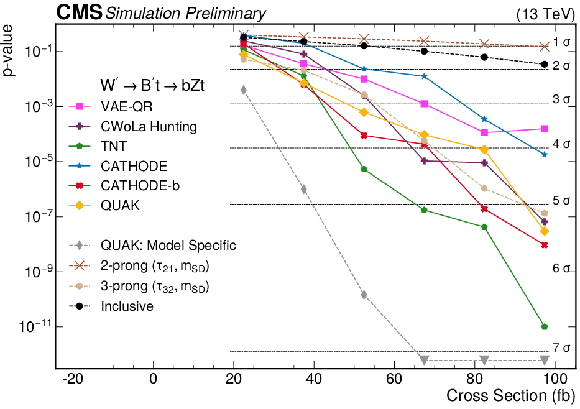
png pdf |
Figure 2-b:
P-values as a function of the injected signal cross sections for the different analysis procedures on for two different signals: (left) the 2-pronged $ \mathrm{X} \to \mathrm{YY'} \to 4 \mathrm{q} $ signal with $ M_{\mathrm{X}}= $ 3 TeV, $ M_{\mathrm{Y}}= $ 170 GeV, and $ M_{\mathrm{Y}'}= $ 170 GeV and (right) 3-pronged $ \mathrm{W^{'}} \to \mathrm{B'}\mathrm{t} \to \mathrm{b} \mathrm{Z} \mathrm{t} $ signal with $ M_{W'}= $ 3 TeV and $ M_{B'}= $ 400 GeV. Significances are restricted to a maximum of 7$ \sigma $, to reflect limitations of the asymptotic formula used. Values larger than this are denoted with a downwards facing triangle. |

png pdf |
Figure 3:
The dijet invariant mass spectrum and resulting background fit to the data for VAE-QR (top left) CWoLa Hunting (top middle), TNT (top right), CATHODE (bottom left), CATHODE-b (bottom middle) and QUAK (bottom right). The shapes of example signals are shown along with the VAE-QR $ m_\mathrm{jj} $ distribution. Though not shown, these shapes are consistent for the other methods as well. For all methods besides the VAE-QR, separate selections were applied for different signal mass hypotheses and the resulting mass spectra were fit separately. The figures therefore show the fitted and observed dijet mass distribution in the signal window of each selection, which results in a discontinuous distribution. The results in the A signal regions are shown for the weakly supervised and QUAK methods. |

png pdf |
Figure 3-a:
The dijet invariant mass spectrum and resulting background fit to the data for VAE-QR (top left) CWoLa Hunting (top middle), TNT (top right), CATHODE (bottom left), CATHODE-b (bottom middle) and QUAK (bottom right). The shapes of example signals are shown along with the VAE-QR $ m_\mathrm{jj} $ distribution. Though not shown, these shapes are consistent for the other methods as well. For all methods besides the VAE-QR, separate selections were applied for different signal mass hypotheses and the resulting mass spectra were fit separately. The figures therefore show the fitted and observed dijet mass distribution in the signal window of each selection, which results in a discontinuous distribution. The results in the A signal regions are shown for the weakly supervised and QUAK methods. |

png pdf |
Figure 3-b:
The dijet invariant mass spectrum and resulting background fit to the data for VAE-QR (top left) CWoLa Hunting (top middle), TNT (top right), CATHODE (bottom left), CATHODE-b (bottom middle) and QUAK (bottom right). The shapes of example signals are shown along with the VAE-QR $ m_\mathrm{jj} $ distribution. Though not shown, these shapes are consistent for the other methods as well. For all methods besides the VAE-QR, separate selections were applied for different signal mass hypotheses and the resulting mass spectra were fit separately. The figures therefore show the fitted and observed dijet mass distribution in the signal window of each selection, which results in a discontinuous distribution. The results in the A signal regions are shown for the weakly supervised and QUAK methods. |

png pdf |
Figure 3-c:
The dijet invariant mass spectrum and resulting background fit to the data for VAE-QR (top left) CWoLa Hunting (top middle), TNT (top right), CATHODE (bottom left), CATHODE-b (bottom middle) and QUAK (bottom right). The shapes of example signals are shown along with the VAE-QR $ m_\mathrm{jj} $ distribution. Though not shown, these shapes are consistent for the other methods as well. For all methods besides the VAE-QR, separate selections were applied for different signal mass hypotheses and the resulting mass spectra were fit separately. The figures therefore show the fitted and observed dijet mass distribution in the signal window of each selection, which results in a discontinuous distribution. The results in the A signal regions are shown for the weakly supervised and QUAK methods. |

png pdf |
Figure 3-d:
The dijet invariant mass spectrum and resulting background fit to the data for VAE-QR (top left) CWoLa Hunting (top middle), TNT (top right), CATHODE (bottom left), CATHODE-b (bottom middle) and QUAK (bottom right). The shapes of example signals are shown along with the VAE-QR $ m_\mathrm{jj} $ distribution. Though not shown, these shapes are consistent for the other methods as well. For all methods besides the VAE-QR, separate selections were applied for different signal mass hypotheses and the resulting mass spectra were fit separately. The figures therefore show the fitted and observed dijet mass distribution in the signal window of each selection, which results in a discontinuous distribution. The results in the A signal regions are shown for the weakly supervised and QUAK methods. |

png pdf |
Figure 3-e:
The dijet invariant mass spectrum and resulting background fit to the data for VAE-QR (top left) CWoLa Hunting (top middle), TNT (top right), CATHODE (bottom left), CATHODE-b (bottom middle) and QUAK (bottom right). The shapes of example signals are shown along with the VAE-QR $ m_\mathrm{jj} $ distribution. Though not shown, these shapes are consistent for the other methods as well. For all methods besides the VAE-QR, separate selections were applied for different signal mass hypotheses and the resulting mass spectra were fit separately. The figures therefore show the fitted and observed dijet mass distribution in the signal window of each selection, which results in a discontinuous distribution. The results in the A signal regions are shown for the weakly supervised and QUAK methods. |
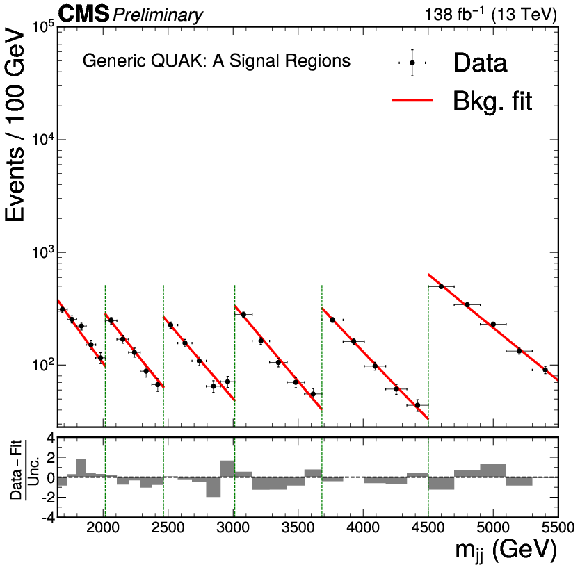
png pdf |
Figure 3-f:
The dijet invariant mass spectrum and resulting background fit to the data for VAE-QR (top left) CWoLa Hunting (top middle), TNT (top right), CATHODE (bottom left), CATHODE-b (bottom middle) and QUAK (bottom right). The shapes of example signals are shown along with the VAE-QR $ m_\mathrm{jj} $ distribution. Though not shown, these shapes are consistent for the other methods as well. For all methods besides the VAE-QR, separate selections were applied for different signal mass hypotheses and the resulting mass spectra were fit separately. The figures therefore show the fitted and observed dijet mass distribution in the signal window of each selection, which results in a discontinuous distribution. The results in the A signal regions are shown for the weakly supervised and QUAK methods. |

png pdf |
Figure 4:
The dijet invariant mass spectrum and resulting background fit to the data for CWoLa Hunting (top lef), TNT (top right), CATHODE (bottom left), CATHODE-b (bottom middle) and QUAK (bottom right). Separate selections were applied for different signal mass hypotheses and the resulting mass spectra were fit separately. The figures therefore show the fitted and observed dijet mass distribution in the signal window of each selection, which results in a discontinuous distribution. The results in the B signal regions are shown. The CATHODE and CATHODE-b methods are not used in the highest mass window of the B signal regions due to limited statistics. They therefore have one fewer signal region shown than the other methods. |

png pdf |
Figure 4-a:
The dijet invariant mass spectrum and resulting background fit to the data for CWoLa Hunting (top lef), TNT (top right), CATHODE (bottom left), CATHODE-b (bottom middle) and QUAK (bottom right). Separate selections were applied for different signal mass hypotheses and the resulting mass spectra were fit separately. The figures therefore show the fitted and observed dijet mass distribution in the signal window of each selection, which results in a discontinuous distribution. The results in the B signal regions are shown. The CATHODE and CATHODE-b methods are not used in the highest mass window of the B signal regions due to limited statistics. They therefore have one fewer signal region shown than the other methods. |

png pdf |
Figure 4-b:
The dijet invariant mass spectrum and resulting background fit to the data for CWoLa Hunting (top lef), TNT (top right), CATHODE (bottom left), CATHODE-b (bottom middle) and QUAK (bottom right). Separate selections were applied for different signal mass hypotheses and the resulting mass spectra were fit separately. The figures therefore show the fitted and observed dijet mass distribution in the signal window of each selection, which results in a discontinuous distribution. The results in the B signal regions are shown. The CATHODE and CATHODE-b methods are not used in the highest mass window of the B signal regions due to limited statistics. They therefore have one fewer signal region shown than the other methods. |

png pdf |
Figure 4-c:
The dijet invariant mass spectrum and resulting background fit to the data for CWoLa Hunting (top lef), TNT (top right), CATHODE (bottom left), CATHODE-b (bottom middle) and QUAK (bottom right). Separate selections were applied for different signal mass hypotheses and the resulting mass spectra were fit separately. The figures therefore show the fitted and observed dijet mass distribution in the signal window of each selection, which results in a discontinuous distribution. The results in the B signal regions are shown. The CATHODE and CATHODE-b methods are not used in the highest mass window of the B signal regions due to limited statistics. They therefore have one fewer signal region shown than the other methods. |

png pdf |
Figure 4-d:
The dijet invariant mass spectrum and resulting background fit to the data for CWoLa Hunting (top lef), TNT (top right), CATHODE (bottom left), CATHODE-b (bottom middle) and QUAK (bottom right). Separate selections were applied for different signal mass hypotheses and the resulting mass spectra were fit separately. The figures therefore show the fitted and observed dijet mass distribution in the signal window of each selection, which results in a discontinuous distribution. The results in the B signal regions are shown. The CATHODE and CATHODE-b methods are not used in the highest mass window of the B signal regions due to limited statistics. They therefore have one fewer signal region shown than the other methods. |
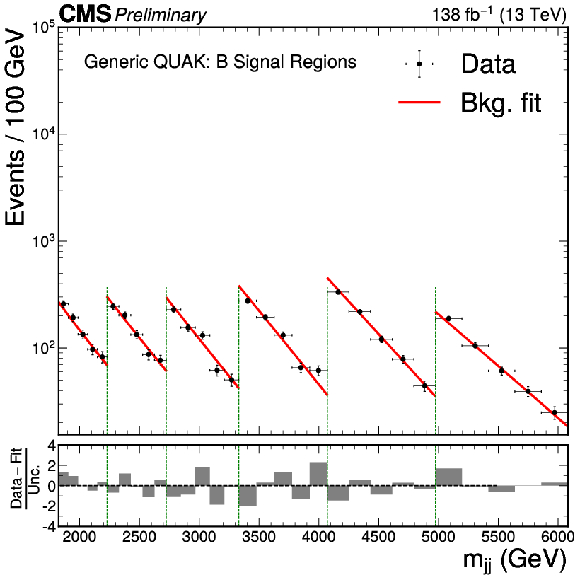
png pdf |
Figure 4-e:
The dijet invariant mass spectrum and resulting background fit to the data for CWoLa Hunting (top lef), TNT (top right), CATHODE (bottom left), CATHODE-b (bottom middle) and QUAK (bottom right). Separate selections were applied for different signal mass hypotheses and the resulting mass spectra were fit separately. The figures therefore show the fitted and observed dijet mass distribution in the signal window of each selection, which results in a discontinuous distribution. The results in the B signal regions are shown. The CATHODE and CATHODE-b methods are not used in the highest mass window of the B signal regions due to limited statistics. They therefore have one fewer signal region shown than the other methods. |

png pdf |
Figure 5:
The discovery sensitivity for the process A $ \to $ BC, using the anomaly detection methods, and a comparison to sensitivity of the inclusive search. In all signal processes, the mass of the heavy resonance was set to $ m(\mathrm{A}) = $ 3 TeV. For the BSM daughter particles, the masses of the $ \mathrm{Y} $ and $ \mathrm{Y'} $ were set to 170 GeV while the masses of the $ \mathrm{B'} $, $ \mathrm{R} $ and H were set to 400 GeV. In the top panel, for each method, the cross section which would have led to an expected 3$ \sigma $ (5$ \sigma $) excess is shown as a cross (square) marker. Sensitivities from six anomaly detection methods (six colors) are compared to an inclusive dijet search in which no substructure selection is made (black) and traditional substructure cuts targeting two-pronged (dark brown) or three-pronged decays (tan). The expected 95% confidence level upper limits from the inclusive search are also shown in the top panel as a dashed line. For all signal models at least one anomaly detection method is able to achieve an expected 5 $ \sigma $ significance at a cross section at or below the upper limit of the inclusive search. In the bottom panel is the ratio of the cross section sensitivity from the inclusive search to the corresponding sensitivity for each method. |

png pdf |
Figure 6:
The upper limit at 95% confidence level on the cross section for the process A$ \rightarrow $BC, is shown for each search method applied to a variety of signal models. For a resonance mass $m(\mathrm{A}) = $ 3 TeV (left) and $m(\mathrm{A}) = $ 5 TeV (right), we show for each signal model (columns), and search method (all colors), the observed limits (Xs), expected limits (squares), and their one standard deviation expected variation (error bars). For the BSM daughter particles, the masses of the $ \mathrm{Y} $ and $ \mathrm{Y'} $ were set to 170 GeV while the masses of the $ \mathrm{B'} $, $ \mathrm{R} $ and H were set to 400 GeV. Limits from the anomaly detection methods (six colors) are compared to those from an inclusive dijet search in which no substructure selection is made (black markers and horizontal lines), traditional substructure cuts targeting two-pronged (dark brown) or three-pronged decays (tan), and the observed limit from a previous CMS search for the $ W_{\mathrm{KK}} $ model in the all-hadronic channel [45] (gray). |
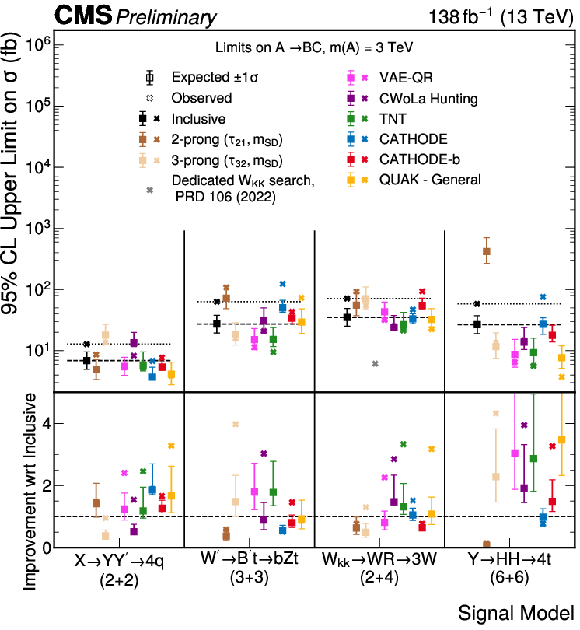
png pdf |
Figure 6-a:
The upper limit at 95% confidence level on the cross section for the process A$ \rightarrow $BC, is shown for each search method applied to a variety of signal models. For a resonance mass $m(\mathrm{A}) = $ 3 TeV (left) and $m(\mathrm{A}) = $ 5 TeV (right), we show for each signal model (columns), and search method (all colors), the observed limits (Xs), expected limits (squares), and their one standard deviation expected variation (error bars). For the BSM daughter particles, the masses of the $ \mathrm{Y} $ and $ \mathrm{Y'} $ were set to 170 GeV while the masses of the $ \mathrm{B'} $, $ \mathrm{R} $ and H were set to 400 GeV. Limits from the anomaly detection methods (six colors) are compared to those from an inclusive dijet search in which no substructure selection is made (black markers and horizontal lines), traditional substructure cuts targeting two-pronged (dark brown) or three-pronged decays (tan), and the observed limit from a previous CMS search for the $ W_{\mathrm{KK}} $ model in the all-hadronic channel [45] (gray). |
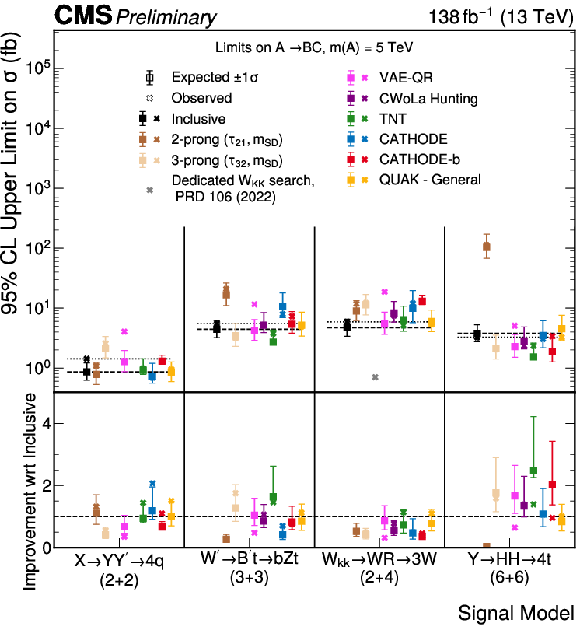
png pdf |
Figure 6-b:
The upper limit at 95% confidence level on the cross section for the process A$ \rightarrow $BC, is shown for each search method applied to a variety of signal models. For a resonance mass $m(\mathrm{A}) = $ 3 TeV (left) and $m(\mathrm{A}) = $ 5 TeV (right), we show for each signal model (columns), and search method (all colors), the observed limits (Xs), expected limits (squares), and their one standard deviation expected variation (error bars). For the BSM daughter particles, the masses of the $ \mathrm{Y} $ and $ \mathrm{Y'} $ were set to 170 GeV while the masses of the $ \mathrm{B'} $, $ \mathrm{R} $ and H were set to 400 GeV. Limits from the anomaly detection methods (six colors) are compared to those from an inclusive dijet search in which no substructure selection is made (black markers and horizontal lines), traditional substructure cuts targeting two-pronged (dark brown) or three-pronged decays (tan), and the observed limit from a previous CMS search for the $ W_{\mathrm{KK}} $ model in the all-hadronic channel [45] (gray). |

png pdf |
Figure 7:
A flow chart outlining how the samples for the weakly supervised training are constructed in the TNT method. See text for details. |

png pdf |
Figure 8:
Diagram of the limit setting procedure for the $ \mathrm{X} \to \mathrm{YY'} \to 4 \mathrm{q} $ signal at 3 TeV with the CATHODE method. The top panel shows the estimated signal acceptance and efficiency as a function of the cross section injected in data. The shaded region shows the total statistical and systematic uncertainty on the efficiency. The resulting $ N_\text{sig}(\sigma) $ curve is shown in blue in the lower panel. The expected and observed limits on the number of signal events are shown as a horizontal solid black line and green dashed lines, respectively, and connected to the corresponding limits on the cross section (vertical lines). The 68% band around the expected limit is displayed similarly. |
| Tables | |

png pdf |
Table 1:
Limits on additional signal models and daughter mass combinations for 3 TeV resonance masses. For each signal, the expected and observed 95% CL upper limit on the signal cross section from the best performing anomaly detection method is reported. The expected limit from the anomaly detection method is also compared to the expected limit of the inclusive search to quantify improvement. For some signals the anomaly detection methods do not improve with respect to the inclusive search. This is indicated by a improvement factor less than one. |

png pdf |
Table 2:
Limits on additional signal models and daughter mass combinations for 5 TeV resonance masses. For each signal, the expected and observed 95% CL upper limit on the signal cross section from the best performing anomaly detection method is reported. The expected limit from the anomaly detection method is also compared to the expected limit of the inclusive search to quantify improvement. For some signals the anomaly detection methods do not improve with respect to the inclusive search. This is indicated by a improvement factor less than one. |

png pdf |
Table 3:
For the A $ \to $ BC searches, the sensitivity improvement of the anomaly detection methods over the best-performing comparison method. The considered comparison methods are the inclusive search, two-prong targeted selection and three-prong targeted selection. The fourth and fifth columns list, for each signal model, the improvement on the exclusion limit for the best performing anomaly detection method for signals at masses of $ m_{\mathrm{A}} = $ 3 and 5 TeV respectively. This is quantified as the ratio of the expected upper limit on the production cross section obtained by the anomaly detection method as compared that of the inclusive search. The sixth column lists the improvement on the 5 $ \sigma $ discovery potential for the best performing anomaly detection method for each signal at $ m_{\mathrm{A}} = $ 3 TeV. This is quantified as the ratio of the cross section which would have led to a 5 $ \sigma $ excess for the anomaly detection method as compared to that of the comparison method. |
| Summary |
| In conclusion, this analysis presents a model-agnostic search for new resonances in the dijet final state. Five separate anomaly detection methods are employed to improve sensitivity to signals which would produce jets with substructure distinct from that of standard QCD multijet events. No significant excesses were observed by any of the methods. The performance of the anomaly detection techniques was illustrated on a set of benchmark narrow resonance signals covering a wide range of substructure signatures. It was found that the anomaly detection methods improved the discovery sensitivity and expected limits on the benchmark signals. The anomaly detection methods were shown to enhance sensitivity by larger factors, and on a much wider class of models, than traditional cut-based substructure selections, but fell short of the sensitivity of a dedicated model-specific search. The performance of the anomaly detection methods on a diverse set of benchmark models demonstrates the sensitivity of the employed techniques to a wide class of dijet resonances which have substructure and fall within the considered mass range. By construction, these approaches have potential sensitivity to an even broader class of models than the specific benchmarks which were studied. The anomaly detection methods employed in this search represent a significant step forward in the search for new particles at the LHC in a model-agnostic fashion. Further development and deployment of these techniques will play a crucial role in maximizing the discovery potential of LHC data. |
| References | ||||
| 1 | UA 1 Collaboration | Two-jet mass distributions at the CERN proton-antiproton collider | Physics Letters B 209 (1988) 127 | |
| 2 | UA 2 Collaboration | A measurement of two-jet decays of the W and Z bosons at the CERN $ p\bar{p} $ collider | Zeitschrift für Physik C Particles and Fields 49 (1991) 17 Zeitschrift für Physik C Particles and Fields 49 (1991) 17 |
|
| 3 | CDF Collaboration | Two-jet invariant-mass distribution at $ \sqrt{s}= $ 1.8 TeV | PRD 41 (1990) 1722 | |
| 4 | D0 Collaboration | Search for new particles in the two-jet decay channel with the D0 detector | PRD 69 (2004) 111101 | |
| 5 | ATLAS Collaboration | Search for new particles in two-jet final states in 7 TeV proton-proton collisions with the ATLAS detector at the LHC | PRL 105 (2010) 161801 | |
| 6 | ATLAS Collaboration | Search for new phenomena in dijet mass and angular distributions from pp collisions at $ \sqrt{s}= $ 13 TeV with the ATLAS detector | Physics Letters B 754 (2016) 302 | |
| 7 | CMS Collaboration | Search for dijet resonances in 7 TeV $ pp $ collisions at cms | PRL 105 (2010) 211801 | |
| 8 | CMS Collaboration | Search for high mass dijet resonances with a new background prediction method in proton-proton collisions at $ \sqrt{s} = $ 13 TeV | JHEP 05 (2020) 033 | CMS-EXO-19-012 1911.03947 |
| 9 | ATLAS Collaboration | Combination of searches for heavy resonances decaying into bosonic and leptonic final states using 36 fb$^{-1}$ of proton-proton collision data at $ \sqrt{s}= $ 13 TeV with the ATLAS detector | PRD 98 (2018) 052008 | |
| 10 | CMS Collaboration | A multi-dimensional search for new heavy resonances decaying to boosted WW, WZ, or ZZ boson pairs in the dijet final state at 13 TeV | EPJC 80 (2020) 237 | |
| 11 | CMS Collaboration | Search for new heavy resonances decaying to WW, WZ, ZZ, WH, or ZH boson pairs in the all-jets final state in proton-proton collisions at s=13TeV | PLB 844 (2023) 137813 | 2210.00043 |
| 12 | ATLAS Collaboration | Search for resonant pair production of Higgs bosons in the $ b\bar{b}b\bar{b} $ final state using $ pp $ collisions at $ \sqrt{s} = $ 13 TeV with the ATLAS detector | PRD 105 (2022) 092002 | 2202.07288 |
| 13 | CMS Collaboration | Search for resonant pair production of higgs bosons decaying to two bottom quark-antiquark pairs in proton-proton collisions at 8 TeV | PLB 749 (2015) 560 | |
| 14 | ATLAS Collaboration | Search for low-mass resonances decaying into two jets and produced in association with a photon using pp collisions at $ \sqrt{s}= $ 13 TeV with the ATLAS detector | PLB 795 (2019) 56 | |
| 15 | ATLAS Collaboration | Search for resonances in the mass distribution of jet pairs with one or two jets identified as $ b $-jets in proton-proton collisions at $ \sqrt{s}= $ 13 TeV with the ATLAS detector | PRD 98 (2018) 032016 | |
| 16 | CMS Collaboration | Search for low-mass resonances decaying into bottom quark-antiquark pairs in proton-proton collisions at $ \sqrt{s}= $ 13 TeV | PRD 99 (2019) 012005 | |
| 17 | CMS Collaboration | Search for narrow resonances in the b-tagged dijet mass spectrum in proton-proton collisions at $ \sqrt{s}= $ 13 TeV | PRD 108 (2023) 012009 | |
| 18 | ATLAS Collaboration | Search for heavy particles decaying into a top-quark pair in the fully hadronic final state in $ pp $ collisions at $ \sqrt{s} = $ 13 TeV with the ATLAS detector | PRD 99 (2019) 092004 | |
| 19 | CMS Collaboration | Search for $ t\bar{t} $ resonances in highly boosted lepton+jets and fully hadronic final states in proton-proton collisions at $ \sqrt{s} = $ 13 TeV | JHEP 2017 (2017) 1 | |
| 20 | CMS Collaboration | Search for resonant $ t\bar{t} $ production in proton-proton collisions at $ \sqrt{s} = $ 13 TeV | JHEP 2019 (2019) 31 | CMS-B2G-17-017 |
| 21 | G. Kasieczka et al. | The LHC Olympics 2020: A Community Challenge for Anomaly Detection in High Energy Physics | 2101.08320 | |
| 22 | ATLAS Collaboration | Dijet resonance search with weak supervision using $ \sqrt{s}= $ 13 TeV $ pp $ collisions in the ATLAS detector | PRL 125 (2020) 131801 | 2005.02983 |
| 23 | ATLAS Collaboration | Anomaly detection search for new resonances decaying into a Higgs boson and a generic new particle $ X $ in hadronic final states using $ \sqrt{s} = $ 13 TeV $ pp $ collisions with the ATLAS detector | PRD 108 (2023) 052009 | 2306.03637 |
| 24 | ATLAS Collaboration | Search for New Phenomena in Two-Body Invariant Mass Distributions Using Unsupervised Machine Learning for Anomaly Detection at $\sqrt{s} = $ 13 TeV with the ATLAS Detector | PRL 132 (2024) 081801 | 2307.01612 |
| 25 | CMS Collaboration | The CMS Experiment at the CERN LHC | JINST 3 (2008) S08004 | |
| 26 | CMS Collaboration | Performance of the CMS Level-1 trigger in proton-proton collisions at $ \sqrt{s} = $ 13 TeV | JINST 15 (2020) P10017 | CMS-TRG-17-001 2006.10165 |
| 27 | CMS Collaboration | The CMS trigger system | JINST 12 (2017) P01020 | CMS-TRG-12-001 1609.02366 |
| 28 | CMS Collaboration | Particle-flow reconstruction and global event description with the CMS detector | JINST 12 (2017) P10003 | CMS-PRF-14-001 1706.04965 |
| 29 | CMS Collaboration | Pileup mitigation at CMS in 13 TeV data | JINST 15 (2020) P09018 | CMS-JME-18-001 2003.00503 |
| 30 | D. Bertolini, P. Harris, M. Low, and N. Tran | Pileup per particle identification | JHEP 10 (2014) 059 | 1407.6013 |
| 31 | CMS Collaboration | Jet energy scale and resolution in the CMS experiment in pp collisions at 8 TeV | JINST 12 (2017) P02014 | CMS-JME-13-004 1607.03663 |
| 32 | J. Alwall et al. | The automated computation of tree-level and next-to-leading order differential cross sections, and their matching to parton shower simulations | JHEP 07 (2014) 079 | 1405.0301 |
| 33 | R. D. Ball et al. | A first unbiased global NLO determination of parton distributions and their uncertainties | NPB 838 (2010) 136 | 1002.4407 |
| 34 | NNPDF Collaboration | Parton distributions for the LHC Run II | JHEP 04 (2015) 040 | 1410.8849 |
| 35 | NNPDF Collaboration | Parton distributions from high-precision collider data | EPJC 77 (2017) 663 | 1706.00428 |
| 36 | T. Sjöstrand et al. | An introduction to PYTHIA 8.2 | Comput. Phys. Commun. 191 (2015) 159 | 1410.3012 |
| 37 | CMS Collaboration | Extraction and validation of a new set of CMS PYTHIA8 tunes from underlying-event measurements | EPJC 80 (2020) 4 | CMS-GEN-17-001 1903.12179 |
| 38 | U. Baur, I. Hinchliffe, and D. Zeppenfeld | Excited Quark Production at Hadron Colliders | Int. J. Mod. Phys. A 2 (1987) 1285 | |
| 39 | U. Baur, M. Spira, and P. M. Zerwas | Excited Quark and Lepton Production at Hadron Colliders | PRD 42 (1990) 815 | |
| 40 | D. Barducci et al. | Exploring Drell-Yan signals from the 4D Composite Higgs Model at the LHC | JHEP 04 (2013) 152 | 1210.2927 |
| 41 | CMS Collaboration | Search for a W' boson decaying to a vector-like quark and a top or bottom quark in the all-jets final state at $ \sqrt{\mathrm{s}} = $ 13 TeV | JHEP 09 (2022) 088 | 2202.12988 |
| 42 | K. Agashe, P. Du, S. Hong, and R. Sundrum | Flavor Universal Resonances and Warped Gravity | JHEP 01 (2017) 016 | 1608.00526 |
| 43 | K. Agashe et al. | Dedicated Strategies for Triboson Signals from Cascade Decays of Vector Resonances | PRD 99 (2019) 075016 | 1711.09920 |
| 44 | CMS Collaboration | Search for resonances decaying to three W bosons in proton-proton collisions at $ \sqrt{s} = $ 13 TeV | PRL 129 (2022) 021802 | 2201.08476 |
| 45 | CMS Collaboration | Search for resonances decaying to three $ W $ bosons in the hadronic final state in proton-proton collisions at $ \sqrt s = $ 13 TeV | PRD 106 (2022) 012002 | 2112.13090 |
| 46 | A. Carvalho | Gravity particles from Warped Extra Dimensions, predictions for LHC | 1404.0102 | |
| 47 | D. P. Kingma and M. Welling | Auto-encoding variational bayes | 1312.6114 | |
| 48 | Y. L. Dokshitzer, G. D. Leder, S. Moretti, and B. R. Webber | Better jet clustering algorithms | JHEP 08 (1997) 001 | hep-ph/9707323 |
| 49 | Wozniak, Kinga Anna et al. | New physics agnostic selections for new physics searches | EPJ Web Conf. 245 (2020) 06039 | |
| 50 | E. M. Metodiev, B. Nachman, and J. Thaler | Classification without labels: learning from mixed samples in high energy physics | JHEP 2017 (2017) 174 | |
| 51 | J. H. Collins, K. Howe, and B. Nachman | Extending the search for new resonances with machine learning | PRD 9 (2019) 014038 | |
| 52 | O. Amram and C. M. Suarez | Tag N\textquoteright Train: a technique to train improved classifiers on unlabeled data | JHEP 01 (2021) 153 | 2002.12376 |
| 53 | A. Hallin et al. | Classifying anomalies through outer density estimation | PRD 106 (2022) 055006 | 2109.00546 |
| 54 | A. J. Larkoski, S. Marzani, G. Soyez, and J. Thaler | Soft drop | JHEP 2014 (2014) 146 | |
| 55 | J. Thaler and K. Van Tilburg | Identifying boosted objects with n-subjettiness | JHEP 2011 (2011) 15 | |
| 56 | C. Brust et al. | Identifying boosted new physics with non-isolated leptons | JHEP 2015 (2015) 79 | |
| 57 | CMS Collaboration | Identification of heavy-flavour jets with the CMS detector in pp collisions at 13 TeV | JINST 13 (2018) P05011 | CMS-BTV-16-002 |
| 58 | M. Farina, Y. Nakai, and D. Shih | Searching for New Physics with Deep Autoencoders | PRD 101 (2020) 075021 | 1808.08992 |
| 59 | T. Heimel, G. Kasieczka, T. Plehn, and J. M. Thompson | QCD or What? | SciPost Phys. 6 (2019) 030 | 1808.08979 |
| 60 | D. J. Rezende and S. Mohamed | Variational inference with normalizing flows | Proceedings of the 32nd International Conference on International Conference on Machine Learning, 2016 link |
1505.05770 |
| 61 | G. Papamakarios, T. Pavlakou, and I. Murray | Masked autoregressive flow for density estimation | link | |
| 62 | M. Germain, K. Gregor, I. Murray, and H. Larochelle | MADE: masked autoencoder for distribution estimation | link | 1502.03509 |
| 63 | C. Durkan, A. Bekasov, I. Murray, and G. Papamakarios | Neural spline flows | Curran Associates Inc., Red Hook, NY, USA, 2019 | 1906.04032 |
| 64 | R. van den Berg, L. Hasenclever, J. M. Tomczak, and M. Welling | Sylvester normalizing flows | Proceedings of the Conference on Uncertainty in Artificial Intelligence (UAI), 2018 link |
1803.05649 |
| 65 | L. Dinh, J. Sohl-Dickstein, and S. Bengio | Density estimation using real NVP | Proceedings of the International Conference on Learning Representations, 2017 link |
1605.08803 |
| 66 | D. P. Kingma and P. Dhariwal | Glow: Generative flow | 1807.03039 | |
| 67 | L. Dinh, D. Krueger, and Y. Bengio | Nice: Non-linear independent components estimation | 1410.8516 | |
| 68 | J. Brehmer and K. Cranmer | Flows for simultaneous manifold learning and density estimation | Proceedings of the 34th International Conference on Neural Information Processing Systems, 2020 | 2003.13913 |
| 69 | S. E. Park et al. | Quasi Anomalous Knowledge: Searching for new physics with embedded knowledge | JHEP 21 (2020) 030 | 2011.03550 |
| 70 | R. G. Lomax and D. L. Hahs | Statistical Concepts: a Second Course | -Vaughn, . Routledge Academic, London, 2007 link |
|
| 71 | CMS Collaboration | Lund Plane Reweighting for Jet Substructure Correction | Technical Report CMS-DP-2023-046, Geneva, 2923 link |
|
| 72 | F. A. Dreyer, G. P. Salam, and G. Soyez | The Lund Jet Plane | JHEP 12 (2018) 064 | 1807.04758 |
| 73 | H. Fan, H. Su, and L. Guibas | A point set generation network for 3d object reconstruction from a single image | link | 1612.00603 |
| 74 | S. Macaluso and D. Shih | Pulling Out All the Tops with Computer Vision and Deep Learning | JHEP 10 (2018) 121 | 1803.00107 |
| 75 | G. E. P. Box and D. R. Cox | An analysis of transformations | Journal of the Royal Statistical Society: Series B (Methodological) 26 211, 1964 link |
|

|
Compact Muon Solenoid LHC, CERN |

|

|

|

|

|

|